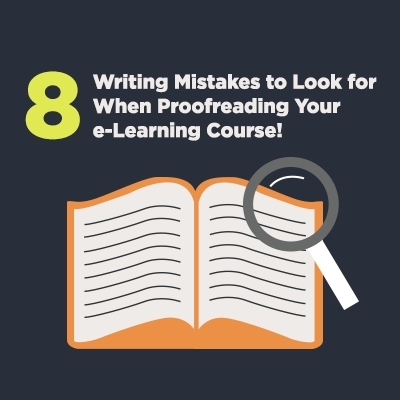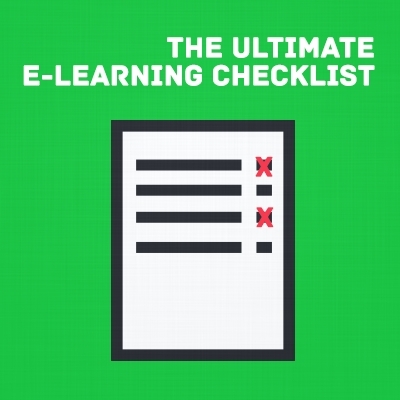To catch any mistakes, read aloud when you’re proofreading; this forces you to slow down, so you don’t miss anything. And by hearing the words on the screen, you’ll pay attention to how your writing sounds and flows.
Look for these 8 writing mistakes when proofreading your e-Learning course
- Subject-Verb Agreement
Make sure all your subjects and verbs agree. That way, your learners won’t be distracted by disagreements, and they’ll focus on what’s most important—your e-Learning content.Wrong: The wombat and the wallaby is from Australia.Correct: The wombat and the wallaby are from Australia. - Pronoun-Antecedent Agreement
Just like subjects and verbs, pronouns and antecedents must always agree. You may be wondering, what’s an antecedent? An antecedent is simply the word or phrase that the pronoun is replacing. Let’s use the word tourist for our antecedent. Wrong: A tourist should remember to pack their camera for photographing the outback animals.Correct: Tourists should remember to pack their cameras for photographing the outback animals. Correct: A tourist should remember to pack his camera for photographing the outback animals. The easiest fix is to make everything plural, but you can also make the sentence singular when gender-specific pronouns are appropriate. - Comma Splices
Don’t squish two sentences together with a comma. If your learners notice this mistake, you’ll immediately lose credibility, so fix any comma splices when you proofread your e-Learning course. Wrong: Lemurs are native to Madagascar, some people buy them for pets. Correct: Lemurs are native to Madagascar. Some people buy them for pets. Even Better: Lemurs are native to Madagascar, but some people buy them for pets. - Homophone Swaps
It’s easy to swap words that sound the same but are spelled differently and have different meanings. Some of the most common homophone errors are with your and you’re, there, their and they’re, its and it’s or hear and here. Be sure to catch any homophone swaps when proofreading, so your learners never see them. - Passive Voice Overload
Use active voice most of the time. Active voice is direct and clear, while passive voice is indirect and can often be confusing. Passive: The baby chinchilla was let out of his cage. Active: Sally let the baby chinchilla out of his cage. Active: The baby chinchilla escaped from his cage.Only use passive voice if you have a specific reason, like if you want to avoid placing blame on Sally, your subject. However, another option is to keep the sentence active and blame the chinchilla. When in doubt, be direct and choose the active construction. - Careless Commas
Who cares about commas? Your learners will—even if they aren’t experts on official comma rules. A couple commas can change the entire meaning of a sentence. Here’s an example:Sentence 1: Koalas which can be seen at the zoo are happy animals.Sentence 2: Koalas, which can be seen at the zoo, are happy animals. Sentence 1 says that koalas at the zoo are the only happy koalas (and koalas in Australia are probably in tears). Sentence 2 says that koalas everywhere are happy animals, and you can also see them at the zoo. To ensure the proper communication of your e-Learning content, don’t be careless with your commas. - Wordiness
Delete extra words and filler phrases. If your learners have to sift through a bunch of sentence clutter, they’ll be annoyed and disengaged in your course. Plus, reading useless words is a waste of time. In The Elements of Style Will Strunk quotes E.B. White: “Omit needless words!” Look for needless words in strings of verbs and excessive prepositional phrases. - Possessive & Plural Confusion
This sounds simple, but it can begin to get confusing when using plural possessives. Keep track of your apostrophes, so you don’t distract your learners with this common mistake. Wrong: Domestic hedgehog’s habitats should be kept at 75 degrees.Wrong: Domestic hedgehogs habitats should be kept at 75 degrees.Correct: Domestic hedgehogs’ habitats should be kept at 75 degrees.
To quickly proofread, edit and get feedback from others, try ReviewLink online course review tool. ReviewLink for Lectora V11 e-Learning software makes it easy to review e-Learning content and communicate with your team throughout the entire review cycle, especially proofreading.
When you’re proofreading your next e-Learning course, look for these 8 writing mistakes. If you also learn to recognize a few of your most common errors, your proofreading will be much more efficient. Plus, instead of irritating learners with distracting mistakes, your e-Learning course will wow your learners with its awesome content!








